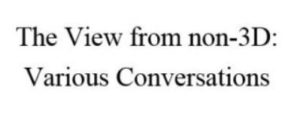
Tuesday, October 23, 2012
Somehow it never occurred to me that I could spend hours at a time (maybe) visualizing, like watching a movie or writing or even reading. Instead I have tended to spend seconds getting a starting image and then trying to work that by conscious processes. Wrong number! I’m going to try it the right way, and what better day to try it than right now?
I’ve been going about this the wrong way. I’ve been desperate to snatch something and not lose it. There isn’t any way I could have lost it except by diverting my own attention.
It may be that it ought to be a combination of daydreaming and taking notes, more or less alternately. Like remote viewing, come to think of it, or – like the conversations I have been having, these years!
Is it possible that I’ve been making so much trouble for myself merely because I’ve been working on the wrong theory?
Dr. Jung, I seem to hear you wishing to chime in.
Yes. You see directed imagination is the key. It may be used to allow material to become conscious. It is not quite the way people think of it, as “moving from the unconscious into the conscious.” More, it is unconscious material being shaped, and that shaping process is consciousness’ gift to the world. It is the shaping that creates out of what until then was only inchoate. The Sistine Chapel did not exist until it was created. To say that it existed as a pattern in the non-material world is not truly a meaningful statement; it is as misleading as it is helpful – helpful mostly in the one context that previously assumed that nothing existed until brought forth into the material world not because it hadn’t been conscious but because (supposedly) nothing existed except the material observable world, the artist’s mind supposedly being merely a part of that.
Well, some sentence.
You are struggling to get the sense of the material as it emerges. You were told long ago that you are not writing scriptures.
No, it’s more like jazz or improvisation I suppose.
Here is the point again. Carefully, now. A work of art, a thought, a formal idea, a scientific theory, a complicated nuanced understanding of an era in history – all such material or non-material artifacts are as the word artifacts implies: they are fashioned, they are wrestled out of the pre-conscious chaos of possibilities and are given form. They are not retrieved, or moved, from one non-place into a place. They are not transferred at all, they are created in the process of wrestling with their materials, with the matrix in which they are found.
All right.
This gives you insight into the creative process! This shows you how to look at that process objectively, outside the necessary subjectivity of any individual’s efforts.
It’s giving me a way to think about creativity?
It gives you the principle of artistic construction that will allow you to deduce certain procedures that will make greater creativity possible for anyone who understands them. Just as you deduced principles of perception and interpretation of impulses of thought, ideas, visions, from the non-material world, so here. It is the same process, merely requiring a simple exposition.
Thank you, I think I see that.
Yes, but use it. That will firm it up for you and will show you how to teach it.